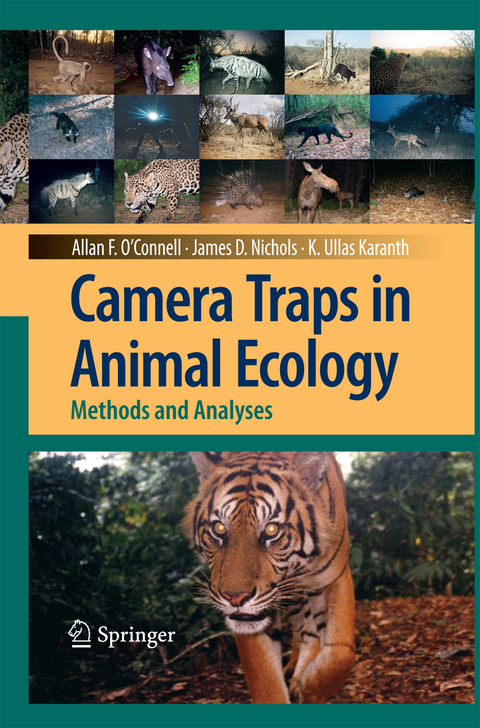
Camera Traps in Animal Ecology
Springer Verlag, Japan
978-4-431-54648-1 (ISBN)
Allan O’Connell is a research wildlife biologist with the U.S. Geological Survey’s Patuxent Wildlife Research Center in Maryland. His research concentrates on wildlife management issues for U.S. federal resource agencies. His cutting-edge work includes the design of multiple technique sampling and monitoring programs to assess biodiversity, the use of camera traps to estimate population parameters, and the investigation of effects of predators on isolated populations of endangered species. James Nichols is a senior scientist with the Patuxent Wildlife Research Center. He is an expert on capture–recapture sampling methods, population modeling, and adaptive management. He has authored or co-authored more than 350 scientific publications, including two books, four edited volumes, and nine monographs, on various aspects of wildlife population ecology. He is a recipient of the 2007 U.S. Presidential Rank Award for Meritorious Service and has received national recognition for his work from various universities, the U.S. Fish and Wildlife Service, U.S. Geological Survey, The Wildlife Society, American Statistical Association, and the U.S. Forest Service. Ullas Karanth is an internationally known conservation scientist (see www.wikipedia.org). Based in India, he is a senior conservation scientist for the Wildlife Conservation Society, where his long-term research has focused on the ecology and conservation of tigers and their prey. He has more than 70 scientific publications to his credit. His work has been featured in the world’s media including the New York Times, Time magazine, National Geographic, BBC, CNN, Discovery, and others. He is the recipient of the Sierra Club’s prestigious international EarthCare Award and the World Wildlife Fund’s J. Paul Getty Award for Conservation Leadership.
1. Introduction: Allan F. O’Connell, James D. Nichols, and K. Ullas Karanth.- 2. A History of Camera Trapping: Thomas E. Kucera and Reginald H. Barrett.- 3. Evaluating Types and Features of Camera Traps in Ecological Studies: A Guide for Researchers: Don E. Swann, Kae Kawanishi, and Jonathan Palmer.- 4. Science, Conservation, and Camera Traps: James D. Nichols, K. Ullas Karanth, and Allan F. O’Connell.- 5. Behavior and Activity Patterns: Andrew S. Bridges and Andrew J. Noss.- 6. Abundance, Density and Relative Abundance: A Conceptual Framework: Timothy G. O’Brien.- 7. Estimating Tiger Abundance from Camera Trap Data: Field Surveys and Analytical Issues: K. Ullas Karanth, James D. Nichols, and N. Samba Kumar.- 8. Abundance/Density Case Study: Jaguars in the Americas: Leonardo Maffei, Andrew J. Noss, Scott C. Silver, and Marcella J. Kelly.- 9. Estimation of Demographic Parameters in a Tiger Population from Long-term Camera Trap Data: K. Ullas Karanth, James D. Nichols, N. Samba Kumar, and Devcharan Jathanna.- 10. Hierarchical Spatial Capture–Recapture Models for Estimating Density from Trapping Arrays: J. Andrew Royle and Beth Gardner.- 11. Inference for Occupancy and Occupancy Dynamics: Allan F. O’Connell Jr and Larissa L. Bailey.- 12. Species Richness and Community Dynamics: A Conceptual Framework: Marc Kéry.- 13. Estimation of Species Richness of Large Vertebrates Using Camera Traps: An Example from an Indonesian Rainforest: Timothy G. O’Brien, Margaret F. Kinnaird, and Hariyo T. Wibisono.- 14. Camera Traps in Animal Ecology and Conservation: What’s Next?: James D. Nichols, Allan F. O’Connell, and K. Ullas Karanth.- Index.
| Erscheint lt. Verlag | 12.10.2014 |
|---|---|
| Zusatzinfo | XIV, 271 p. |
| Verlagsort | Tokyo |
| Sprache | englisch |
| Maße | 155 x 235 mm |
| Themenwelt | Naturwissenschaften ► Biologie ► Zoologie |
| ISBN-10 | 4-431-54648-0 / 4431546480 |
| ISBN-13 | 978-4-431-54648-1 / 9784431546481 |
| Zustand | Neuware |
| Haben Sie eine Frage zum Produkt? |
aus dem Bereich


